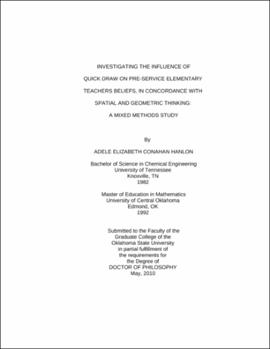| dc.contributor.advisor | Utley, Juliana | |
| dc.contributor.author | Hanlon, Adele Elizabeth Conahan | |
| dc.date.accessioned | 2013-11-26T08:34:31Z | |
| dc.date.available | 2013-11-26T08:34:31Z | |
| dc.date.issued | 2010-05 | |
| dc.identifier.uri | https://hdl.handle.net/11244/7423 | |
| dc.description.abstract | Scope and Method of Study: This embedded quasi-experimental mixed methods study investigated pre-service elementary teachers for the purpose of understanding the influence of an activity called Quick Draw with respect to their geometric thinking, spatial thinking, beliefs regarding spatial thinking, and additionally, their general awareness of spatial and geometric thinking. | |
| dc.description.abstract | Findings and Conclusions: Analyses of variance revealed no significant differences between mean scores of the Van Hiele Geometry Test, Geometric Vocabulary Test, Purdue Spatial Visualization Test, and the Spatial Thinking Attitude Survey with regard to the control and treatment groups of pre-service elementary teachers. Analysis of the qualitative data suggests that the treatment group did feel as though participating in the Quick Draw activities improved their geometric vocabulary, spatial thinking, and ability to draw the representations of the Quick Draw figures. This was accomplished through the integrated experiences of "discussion," with respect to "dimension," "parts," and "names" as contributing factors in the development of their spatial representation skills; thus improving how they organized, constructed, and described the geometric figures; training them to think more spatially. Furthermore, McNemar's test showed a significant increase in the use of the word rhombus in the treatment class establishing a relationship between the Quick Draw activity and Vygotsky's Zone of Proximal Development. Pre-service elementary teachers' views regarding geometric thinking were initially connected to the idea of shape, and they felt as though they were not comfortable with geometric vocabulary. The more comfortable the pre-service elementary teacher was with their own spatial ability, the more applications they saw in aspects of spatial thinking. The more aware the pre-service elementary teacher was of their own spatial thinking, the more emphasis they believed should be placed on the integration of spatial thinking into the elementary curriculum. Overall, pre-service elementary teachers would benefit from an integration of spatial thinking concepts and activities into their curriculum. | |
| dc.format | application/pdf | |
| dc.language | en_US | |
| dc.rights | Copyright is held by the author who has granted the Oklahoma State University Library the non-exclusive right to share this material in its institutional repository. Contact Digital Library Services at lib-dls@okstate.edu or 405-744-9161 for the permission policy on the use, reproduction or distribution of this material. | |
| dc.title | Investigating the influence of quick draw on pre-service elementary teachers beliefs, in concordance with spatial and geometric thinking: A mixed methods study | |
| dc.contributor.committeeMember | Jordan, Pat Lamphere | |
| dc.contributor.committeeMember | Miller, Janice | |
| dc.contributor.committeeMember | Sanders, Jennifer | |
| osu.filename | Hanlon_okstate_0664D_10863 | |
| osu.accesstype | Open Access | |
| dc.type.genre | Dissertation | |
| dc.type.material | Text | |
| dc.subject.keywords | geometric thinking | |
| dc.subject.keywords | mixed-methods study | |
| dc.subject.keywords | pre-service elementary teachers | |
| dc.subject.keywords | purdue spatial visualization test | |
| dc.subject.keywords | spat | |
| thesis.degree.discipline | Teaching and Curriculum Leadership | |
| thesis.degree.grantor | Oklahoma State University | |
